Ethical link-building is the holy grail of SEO — rewarding but demanding.
However, some in the industry get frustrated with how long it takes to see results.
There’s a lot of grumbling behind the scenes!
Now, it’s plain to see why black hat link building can be tempting.
At our white hat link building agency Editorial.Link, we don’t use black hat methods.
The promise of quick traffic and soaring rankings with minimal effort is hard to resist, especially when patience is running thin.
While ambition can push you to try black hat SEO link building for quick wins, it often comes with the risk of Google penalties that could seriously hurt your site’s performance for months.
Is it really worth the hassle?
Consider this:
Key takeaways:
- The core idea of black hat link building is to DELIBERATELY flout Google’s guidelines.
- Black hat SEO link building puts you at risk of manual penalties, algorithmic hits, and deindexing, which can lead to major drops in traffic and revenue.
- Recovering from a penalty can take years and a significant investment to restore your site’s reputation and ranking.
- Once a site picks up toxic links, cleaning it up can be tough, even with specialized tools.
- Black hat practices are always tied to low-quality content and irrelevant linking that frustrates users. In an online world where reputation is your currency, it's a dead end.
- If someone suggests investing in cloaking, PBNs, link farming, or other byproducts of black hat link building, pause. You are 100% wasting your money on something that might stop working the next day.
Feeling a bit overwhelmed? There's still more to dive into!
What is Black Hat Link Building
Black hat link building is creating links with a sole goal of making Google’s algorithms rank them higher, even though they don’t meet its search guidelines whatsoever.
According to Google’s Search Quality Rater Guidelines, links involved in intentional manipulation of rankings are considered to be unnatural. These typically include:
- Untrustworthy, hacked, defaced, spammy, or auto-generated links
- Links that lack authority and relevance
- Links created solely to benefit the website owner
- Links using deceptive methods to rank higher in search results
- Links that discourage the creation of high-quality content by overshadowing well-crafted, original, and useful pages for visitors
Sounds like black hat? You bet!
For even more examples of black hat link building listed by Google, check out its Spam Policies. They cover all the classic, including:
- Cloaking
- Doorway pages
- Code and page injection
- Sneaky redirects
- Hidden text and links
- Keyword stuffing
- Link spam
- User-generated spam
As you can probably imagine, all this inevitably results in both manual and algorithmic penalties, especially with recurrent updates, including the latest March 2024 Core & Spam.
So, what does this mean for you?
✅ Rankings might drop
✅ Organic traffic could decrease
✅ Visibility might be reduced
✅ Revenue may take a hit if you depend on search traffic
✅ Recovering from penalties can be a real time-suck
✅ Your credibility with users might take a hit
Blackhat backlinks might seem appealing as a quick way to boost your site’s rankings. However, as an SEO expert, I have to caution you against it. While these tactics might give you a temporary traffic bump, it’s a risky move. Google’s always updating its algorithms, and once they catch on (which they will), your site could suffer a huge blow. You might even get de-indexed, meaning your site could vanish from search results entirely!
Who’d want that? Definitely not you! But hey, there are always a few volunteers out there…
Industries Practicing Black Hat Link Building
Alright, since we’re diving into WHO’S actually using black hat SEO link building, let the numbers do the talking. According to a survey by Search Engine Roundtable, 51% of SEOs own up to using black hat tactics to some extent.
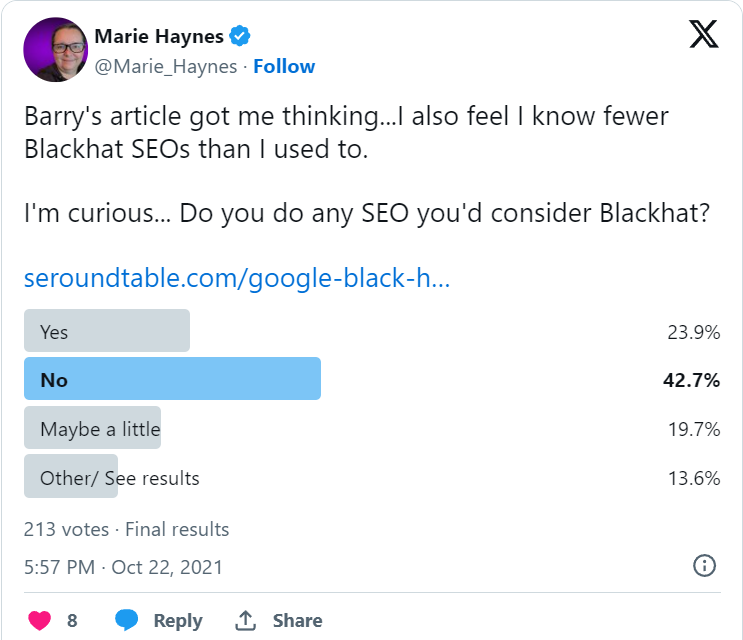
But don’t be too shocked by that big percentage — there’s a reason for it. The poll doesn’t break down which industries these SEOs are from. And here’s the thing: the likelihood of using black hat seo link building techniques can really depend on the industry.
Industries that need quick results, rely heavily on traffic, click-through rates, and aggressive promotion are more likely to turn to black hat tactics. That’s because white hat link building takes time and patience, which might not fit their fast-paced needs.
Websites in niches like gambling, betting, adult content, pharmaceuticals, payday loans, cryptocurrency, and dating are super competitive, hence require instant wins.
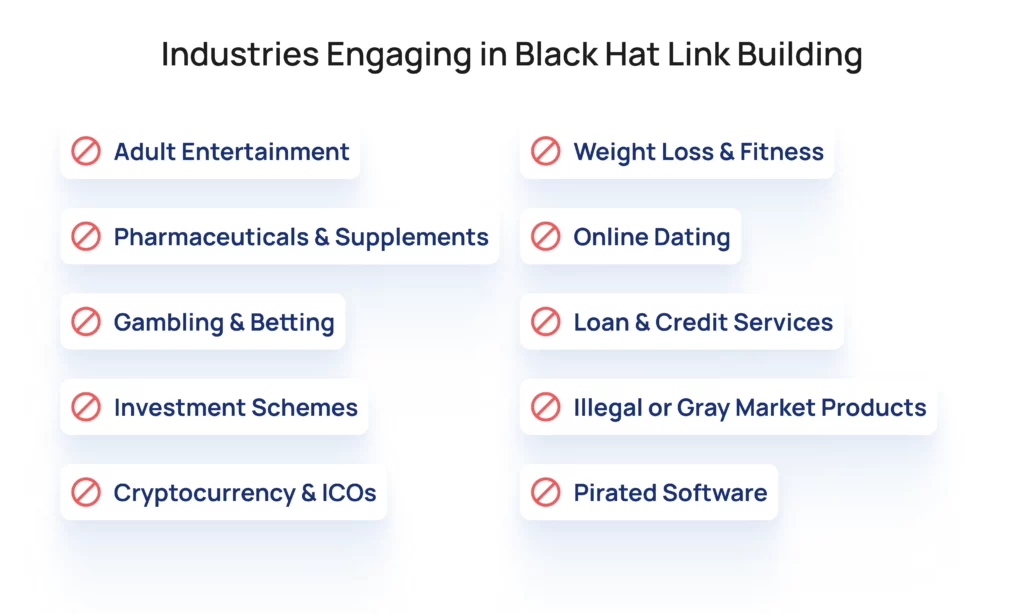
Getting genuine relevant backlinks is tough, and SEO experts in these fields need to be on their toes since Google can hit them with penalties at any moment.
That’s why there’s so much rush!
Black Hat Link Building Techniques To Avoid
Let's get back to basics: any attempt to manipulate Google's algorithms or violate its guidelines falls into the categories of black hat or gray hat SEO.
⚠️Pro-tip! If you're unfamiliar with the term "gray hat," it generally refers to tactics that lie between white hat and black hat practices. For instance, link acquisition methods such as link exchanges can be gray hat if they aren’t based on genuine relationships or relevant connections between sites but are done purely for the sake of linking.
If you’re hunting for a handy list of techniques to avoid, this one’s a keeper!
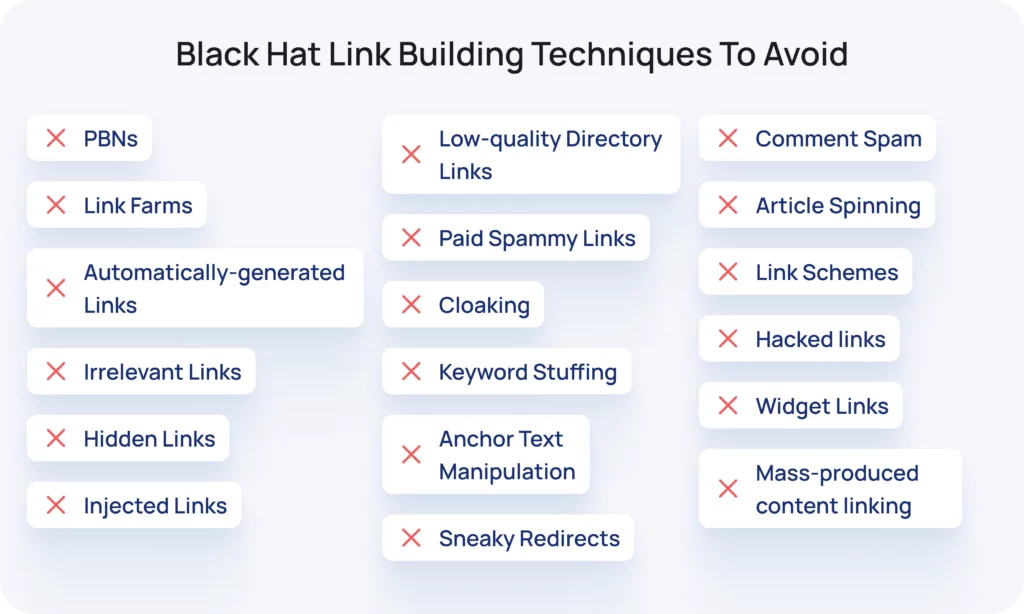
Just remember: we can’t protect you from penalties, de-indexing, recovery costs, or fleeting results, if you are down to using any of these tactics.
Purchasing From Link Farms
Link farms are a classic black hat SEO tactic, involving a network of interconnected websites that boost each other's rankings by passing link juice exclusively among themselves.

You can often spot link farms by looking for websites with the same number of referring domains, similar domain ratings, or low traffic that are suspiciously interlinked.
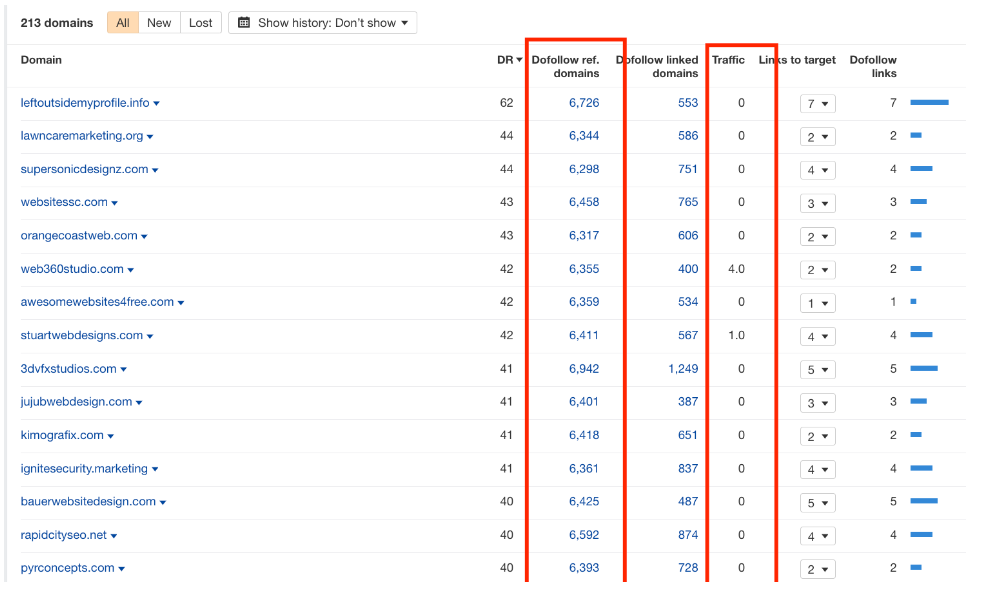
If you’re thinking about purchasing links from link farms, keep in mind that they’re always at risk of being deindexed, regardless of what providers claim or how much you pay.
Take a look at one of the blogging websites such as blogging.org.

Before the March 2024 Core & Spam Update, this blogging site was getting a lot of organic traffic, peaking at 204,678 in January 2024.

After the update, it’s pretty clear the site’s been deindexed — traffic is now at zero, even with a solid backlink profile.

Now, the question is: should this major deindexing be blamed on blogging.org interlinking with a similar site that got hit by the update first?
Let's take a look! What we can see is that blogging.org has a lot of backlinks to techprevue.com, another site that focuses on blogging.
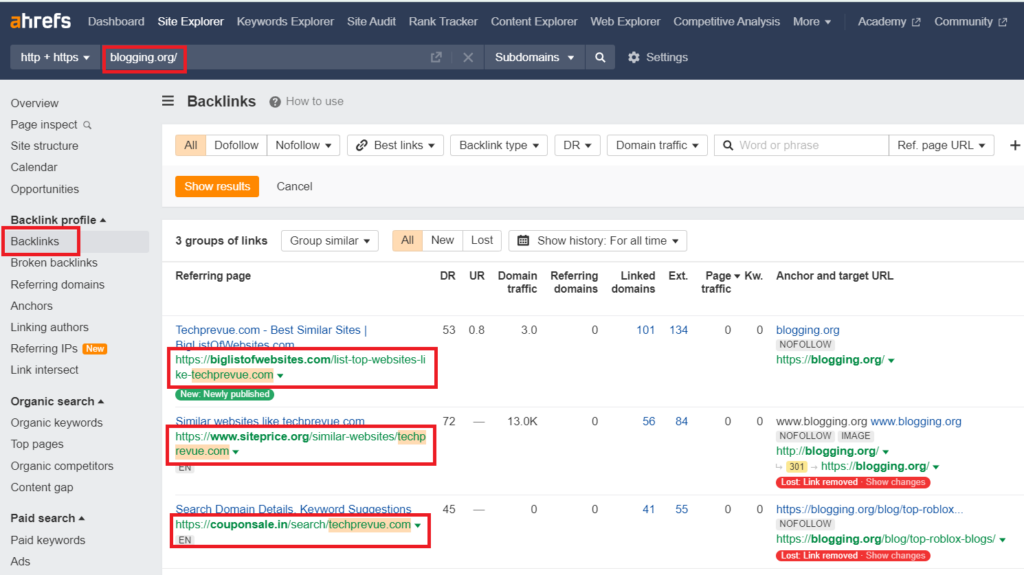
When we check out techprevue.com, it’s the same story: zero traffic and a great backlink profile.

But again, the traffic dropped right after June 2024 Spam Update!

⚠️Pro-tip! We can consider two possibilities here: either both websites were part of a link farm from the start and enjoyed good traffic until the update, or one of them accidentally linked to a toxic site that got deindexed and dragged down all the other backlink profiles involved.
What’s clear is that deindexing doesn’t just happen out of the blue for websites with strong backlink profiles. It’s likely that some black hat tactics were detected and neutralized.
Using PBNs
PBNs are similar to link farms in their manipulative nature, but with a twist. Instead of a network of sites linking to each other randomly, PBNs come from a single “parent website” and create a network where each site passes link juice to those lower in the hierarchy.
Here’s a visual to help illustrate how a PBN works.
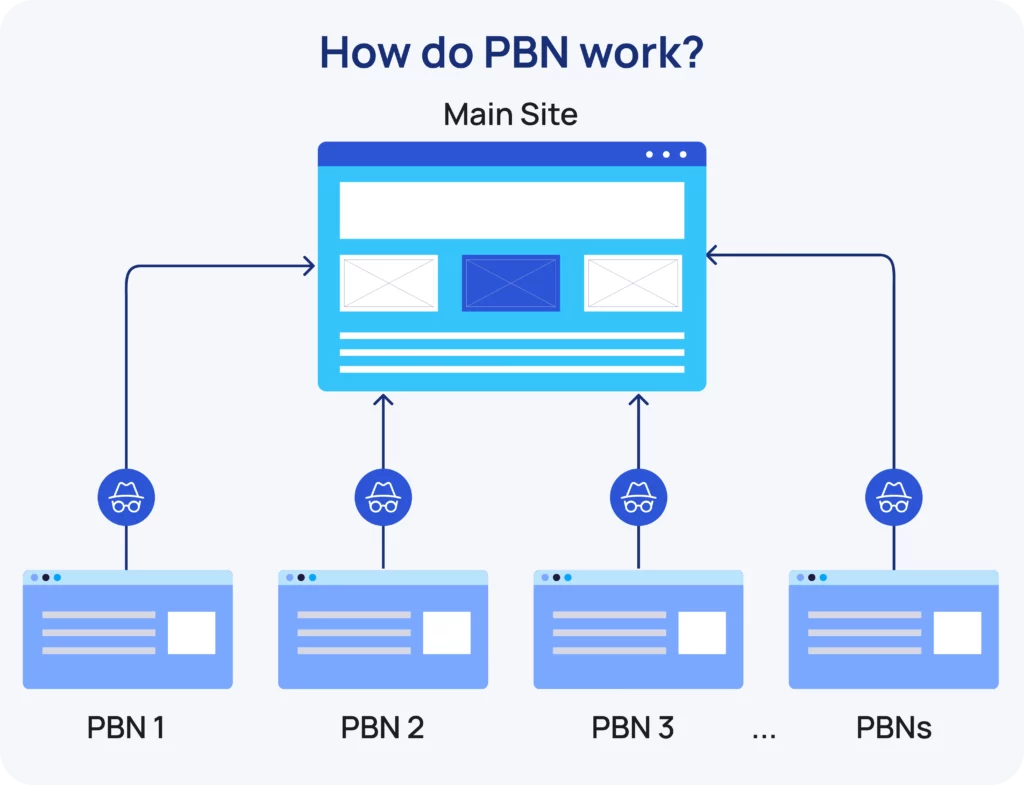
Just like backlinks from link farms, PBN links often have low page traffic and a strong backlink profile.
⚠️Pro-tip! To be 100% sure you're dealing with PBN links, there’s a shortcut: check their IP addresses. Shared IPs usually give PBNs right away. You can use Ahrefs’ Quick Batch Analysis to confirm your guess.
For example, webguiding.net looks pretty solid at first glance with a decent backlink profile.

But when you look at its poor traffic history, it does raise some suspicions.
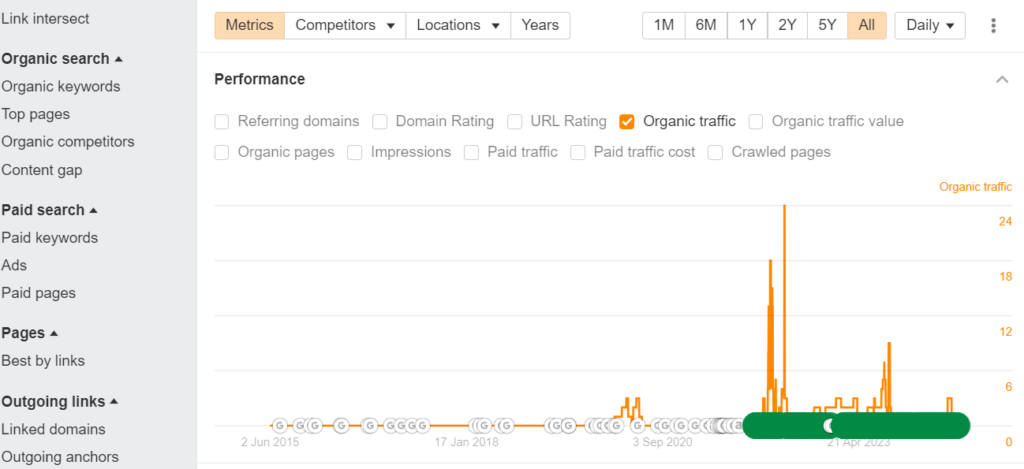
After checking out the related backlinks, the most frequently found ones are:
- free-weblink.com
- link-man.org
Not only do they appear to be low-profile, spammy directory sites at first glance, but Quick Batch Analysis shows that all three share the same IP— definitely a sign of a PBN!
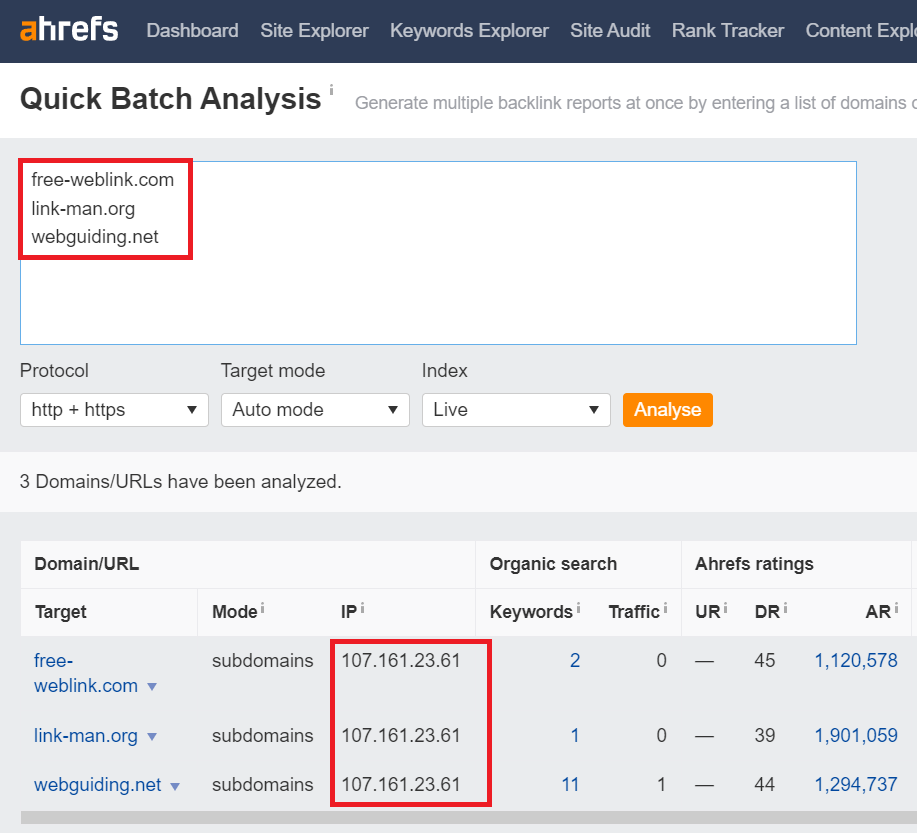
As you can see, Google has already removed most of the bad links, so don’t get your hopes up about a PBN link keeping your traffic up. If it’s not an algorithm update, a manual penalty is likely coming your way.
Building irrelevant links
Another sneaky black hat seo link building technique is dropping irrelevant links just for the sake of passing link juice and pushing rankings. This move flouts Google's Helpful Content Guidelines by either being totally off-topic or pretending to be relevant while leading users to unrelated sites. That’s super frustrating for anyone clicking through!
For example, an article about luxurious apartments might have a link that promises more info on “exceptional” options for choosing a next home.
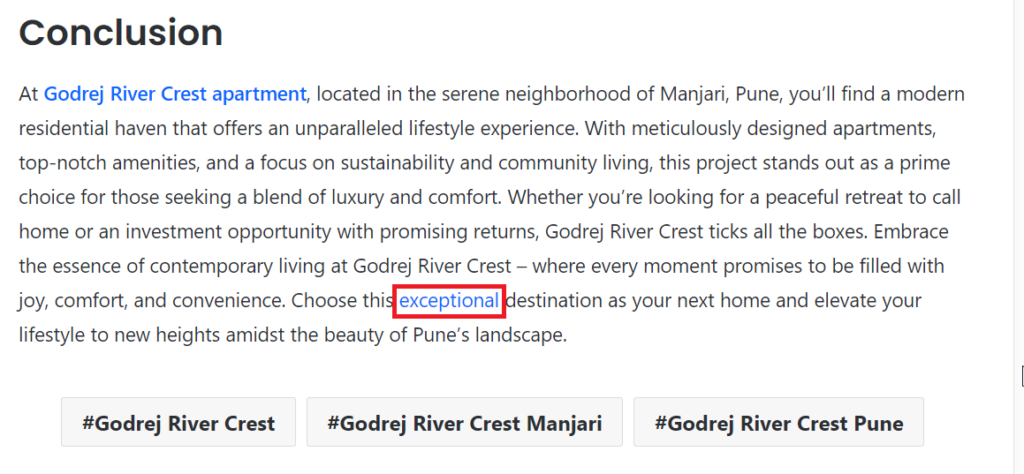
When you click the link, instead of getting more info on elevating your lifestyle, you're redirected to a directory offering various services that have nothing to do with what was promised.

Plus, the website's traffic and backlinks pretty much tell the whole story.

It’s annoying and all too common, especially in niches that are big on aggressive SEO.
Manipulating anchor text
This black hat link building trick involves using irrelevant links and then disguising them with misleading names (anchors) to boost their perceived value and pass link juice.
⚠️Pro-tip! Sometimes, this technique goes hand in hand with keyword stuffing. A misleading link might use anchor text for a popular keyword, but it doesn’t actually fit the content it’s linked to.
For example, one of the blog posts on gotartwork.com talks about the secrets of flawless skincare.

Not only is the text awkwardly packed with keywords to push the skincare brand, but clicking on "Ryan Serhant Skin Care" takes you to lobintech.com — a blog that’s totally unrelated.

It looks like an attempt to boost lobintech.com, which has a lousy backlink profile and no traffic.

Still happening here and there…
🎤 Ask an expert!
“What measures do you take to protect your business or clients from black hat link-building attacks, and have you found them effective?”
I think it’s important to accept that dealing with spam is part of working in SEO. Google has improved at detecting spam, but if it’s clearly spam or a black hat attack, I would disavow the links. The last thing you want is to be doing well and have your site tank because someone’s trying to outrank you
Over-automating link building
Don’t get me wrong — automated link building tools can be really useful for finding high-quality sites, automating tedious tasks, and tracking your SEO progress.
However, overusing tools that mass-generate links for quick results and flood websites with unnecessary links is pure black hat.
Often, spammers use tools like RankerX and GSA in comment sections to spread their links and boost link juice for dead-end websites, hoping that someone might click on them occasionally.
Check out this thread full of identical comments with links promoting supplements.

None of them are relevant to the blog post and clearly weren’t individually copied and pasted — spammers use automated tools to churn out these mass-generated comments.
⚠️Pro-tip! Attacks involving massive spam volumes can be part of negative SEO, where black hatters try to knock down websites they’re competing with. Search engines see large amounts of spam as a violation of user experience and will penalize those sites accordingly.
Abusing cloaking, redirects & hacked site links
Cloaking is a black hat link building technique aimed to manipulate rankings by showing search engine crawlers one version of content while users see a different one.
The trick is to make search engines believe that such content meets their quality guidelines, while ignoring the user experience, often leaving visitors with spammy and irrelevant content.
When it comes to redirects, they’re essentially a form of cloaking. A URL might be indexed for certain keywords, but when users click on it, they’re taken to a completely different website, which misleads them from the content they were looking for.
For example, let’s say you visit federacionvenezolanadefutbol.org, the official site for Venezuela’s soccer federation.
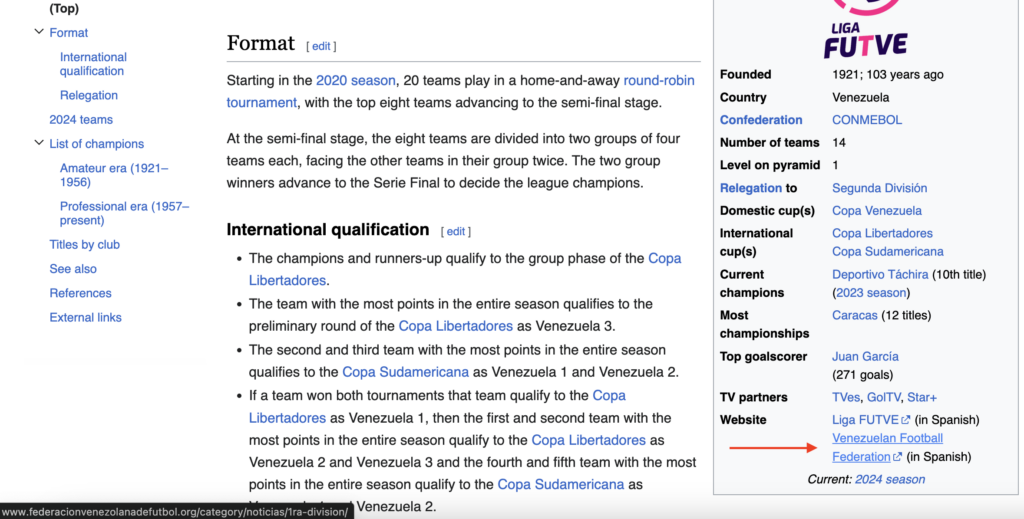
Now, if we check this site on Ahrefs, we can spot a redirect.

Following this 301 redirect, it takes us to a random site related to betting or gambling.

Cloaking and redirects are some of the most common tricks used by black hatters when they hack your website. Typically, they’d stuff it with links to boost traffic and rankings for the sites they want, all at your expense.
As we mentioned earlier, this falls under the umbrella of a negative SEO attack, similar to what happened with RoofingCalc.com, PickHvac.com, and RemodelingCalculator.org, according to a recent post by a SEO expert on Reddit.
These sites were hit with tens of thousands of unnatural external links from a network of hacked websites, using cloaked pages that show one version to Google and a completely different one to users, namely:
☢️ Cloaked domains/URLs: Often, these pages feature a copy-and-paste of the target website’s content or HTML code. You can’t see this directly unless you’re accessing it as a Google bot, thanks to the cloaking setup.
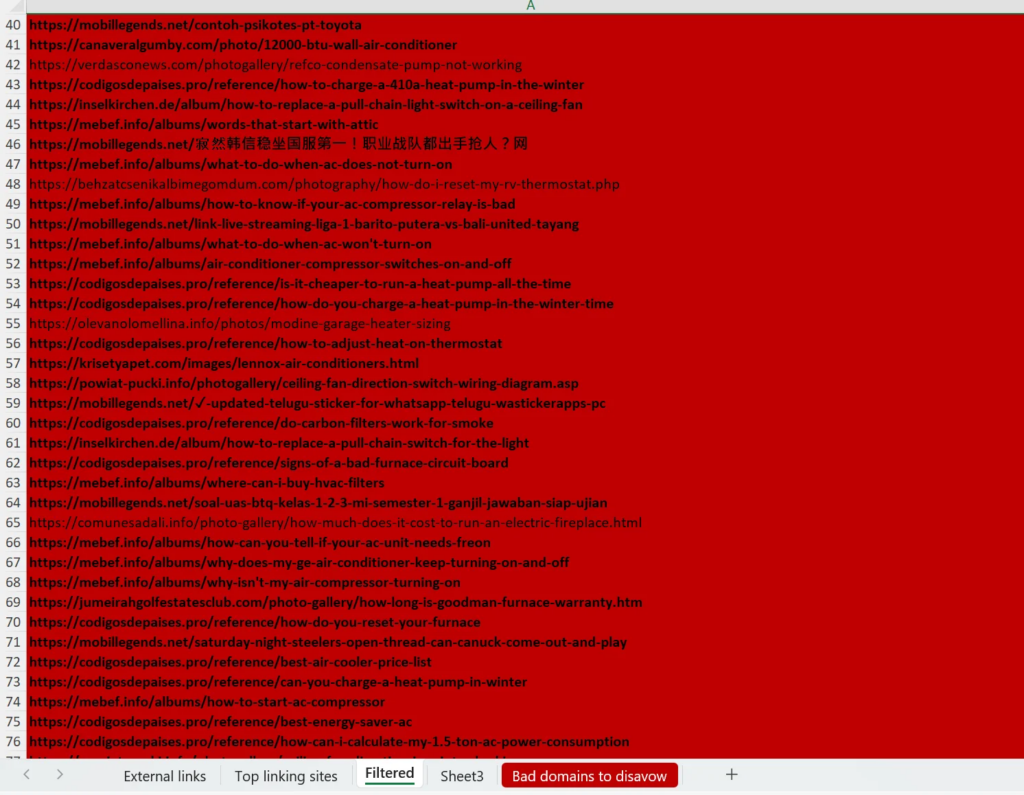
☢️ Cloaked websites/URLs on unrelated domains: These cloaked pages often contain malware and redirect users to:
- Subdomains
- Chinese domains
- Low-quality wiki sites
- Adult-themed sites
- Gambling-themed sites

⚠️Pro-tip!The more black hat SEO tactics are used on your site, the harder it is to clean up the mess. So, it’s a good idea to stay alert and check your site for any signs of trouble.
Hidden linking
Using hidden links is a black hat link building hack that embeds links in a way that's not visible to users but detectable by search engines in order to mislead them for better ranking. This includes using tiny font sizes, matching the text color to the background, or placing links in off-screen positions.
Sometimes, manipulative links can be injected in the website code, and you won’t know about their existence unless you get a penalty or a warning from search engines.

⚠️Pro-tip! Hidden links appeal to black hatters as they allow for covert spamming of websites. By disguising the links, black hat SEOs can insert them on third-party sites without the host's consent. This method exploits bad bots, which made up 49.6% of internet traffic in 2023, while human traffic fell to 50.4%
Bots are one of the most pervasive and growing threats facing every industry. From simple web scraping to malicious account takeover, spam, and denial of service, bots negatively impact an organization’s bottom line by degrading online services and requiring more investment in infrastructure and customer support
If you’ve got a warning or think your site might be under attack, here’s how to turn things around:
✅ Run an on-site link audit to spot any hidden links.
✅ Use anti spam plugins and extensions to block spammers.
✅ Set up a strong web application firewall.
✅ Check your source code and keep an ear out for user feedback.
🎤 Ask an expert!
“What’s the most audacious black hat link-building scheme you've seen succeed without detection, and what does it say about the flaws in Google's system?”
One of the most audacious black hat tactics I’ve encountered is “address spoofing.” This involves creating a fake road or address that targets a specific keyword. The idea is to trick Google’s local search algorithm into thinking there’s a legitimate location associated with that keyword. When users search for the keyword, they are directed to this fabricated address, which, in reality, redirects them to an actual business that offers the product or service related to that keyword.
This tactic exploits the loopholes in how Google’s system verifies addresses and locations, revealing a significant vulnerability. It shows that while Google’s algorithms are advanced, they can still be manipulated through creative yet unethical means. This highlights the ongoing challenge for search engines to tighten their verification processes to ensure that local search results are both accurate and trustworthy.
How to Identify Black Hat Links?
Well, you’ll definitely notice if your rankings drop or if you get hit with a manual penalty. But it's always better to prevent issues than to fix them later.
So, check out these tips to stay ahead of the game!
Watch out for manual actions
If your site has a bunch of black hat links, you might get a manual action from Google. Don’t worry too much — it’s something you can track in the Search Console. Unlike automatic penalties, these are handed out by actual Google evaluators, so you’ve got a better chance to fix things up.
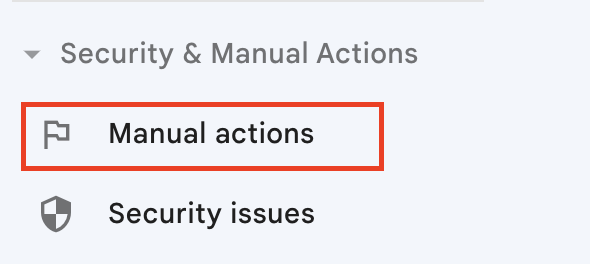
Spotted this notification? Great news — your site is in the clear with manual actions!

If not, you'll get a “Message” letting you know there's a manual action on your site.
⚠️Pro-tip! If you run into a problem, Google will let you know what’s wrong and give you tips to fix it, including which pages are affected. After you clean up any bad links, just ask Google for a review. Recovery might take a few days to weeks, or sometimes a bit longer.
Audit regularly
This is your go-to fix for any existing manual actions. But even if you’re not dealing with one right now, SEO pros suggest checking in regularly to stay ahead of any potential penalties — especially if you’ve been buying links, working with third-party link builders, or have competitors who might be playing dirty.
You’ve got plenty of tools to help with this, like Ahrefs, SEMrush, or Moz, which are great for auditing your website’s backlinks. If you don’t have access to those, no worries — Google Search Console is a solid, free option.
🎤 Ask an expert!
“Is there a secret 'gray area' where black hat tactics are used under the radar without major consequences — how do experts navigate this?”
I’d say most SEO agencies and consultants are already doing this. They often rely on outreach, which usually ends up being paid links.
The key is to use other methods to make sure your anchors and backlinks appear as natural as possible. Building a legitimate brand also helps — it makes things easier and gives you more leeway!
Know black hat ways
Since you’re already familiar with the examples of black hat link building and how black hat link building can destroy your SEO, you should monitor your website’s performance for:
😒 Weird link velocity & patterns: watch out for any sudden jumps in backlinks or links from shady or unrelated sites.
😒 Poor-quality website content & visuals: links from spammy sites or ones with irrelevant content might be a red flag.
😒 Incognito mode: this is when you have no information about who runs a website you are linking to.
😒 Deceptive anchor text: if you notice external links with exact match keywords, NSFW anchor text, or text in a foreign language, it could be a sign of manipulation.
😒 Suspicious link schemes: these include link farms and PBNs that have strong backlink profiles but don’t get much traffic or share similar IP addresses.
😒 Invisible malignant inserts: track links that are hidden in the background, disguised in text, code, or otherwise hard to spot.
Clean up!
Phew, now that we've found all those pesky links, it's time to say goodbye to them! You might want to report some to the webmasters of the linking sites and politely ask them to remove the bad ones.
⚠️Pro-tip! Make sure to give webmasters the details on which links are problematic and why they should be removed.
For the links you can't remove yourself or haven't contacted webmasters about, you can use Google’s disavow link tool.
It's super simple: just create a disavow txt file with websites you want Google to ignore.

Then, upload it to Google Search Console.
Once uploaded, Google will instruct its crawlers to ignore these links, which is a lot easier than asking each site to remove them individually.
⚠️Pro-tip! If you're new to using the Disavow tool, don't worry — you're in good company. Our recent survey of 113 SEO experts around the globe found that only 31% actually use the Disavow tool, while the other 69% don't.
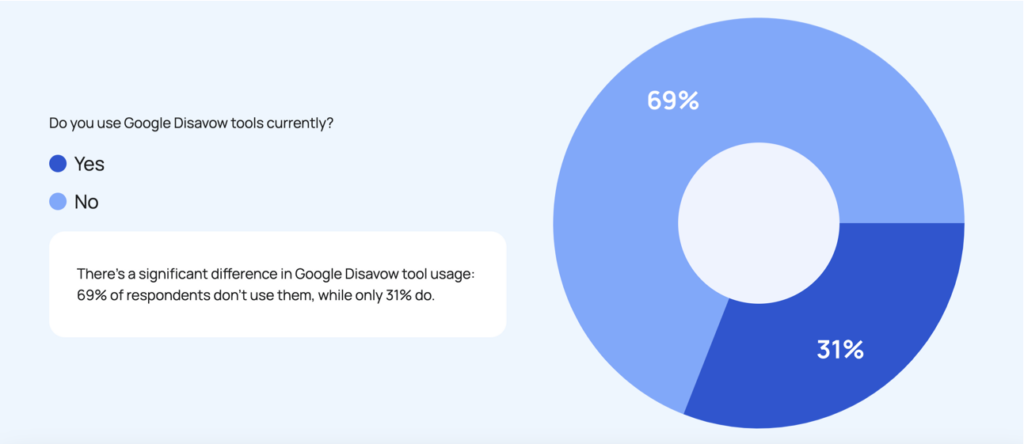
🎤 Ask an expert!
“What trends do you foresee in the way search engines will deal with black hat SEO practices over the next few years?”
This may sound a bit like a “conspiracy theory”, but I think that Google uses specific elements to train its algos. For example, like the “rel=sponsored”. I think that was a way to find patterns regarding buying links.
So, what I mean is, I believe Google will use a set of “things” to detect patterns. Similar to how it calculates document similarity, it can calculate similarity of “footprints” or actions to determine black hat activity.
Search engines will intensify their fight against black hat SEO by using AI-powered detection of manipulative tactics, imposing stricter penalties for violators, and making real-time algorithm fixes to stay ahead of black hat tactics. What we should do as SEOs and Link Builders is create genuine connections with websites within our niche in order to build strong and real backlinks.
Alternatives to Black Hat Link Building
Of course it’s building high-authority backlinks! But it takes time and effort, especially for a new website, so black hat methods might seem tempting.
Anyway, there’s a middle ground with faster, quality link-building — you can always delegate the task to a professional link building agency.
Here are your top reasons:
👍 It’s a proven method for premium link-building through trusted connections with website owners, admins, and editors. This way, you get high-quality, authoritative links naturally and fairly quickly.
👍 Pro agencies have the know-how and tools to keep your site safe from negative SEO, competitor attacks, unnatural patterns, and hidden links. Plus, they can handle your SEO audits on your own convenient schedule.
👍Top link-building agencies like Editorial.Link can create a customized link-building plan for you to have clear instructions on how to earn links naturally in your niche without using black or gray hat tactics.
Need a top-notch link-building agency with solid industry expertise and a proven white hat track record? With Editorial.Link you’ll never need black hat again! From quality link acquisition to thorough audits and planning, your SEO, reputation, and rankings are in the right hands.
Final Words
Now that you're well-versed in black hat link building, you know it’s just a scam and has nothing to do with genuine link building.
We’re not saying you won’t sometimes be targeted by black hat tactics in a negative SEO attack, but let them try. They won’t get far, while you’ll see steady results by sticking to ethical link building ONLY.
If you need guidance or are tempted by black hat tactics, contact your rescue team at Editorial.Link. We can provide plenty of reasons why black hat isn’t the way to go in 2025.







